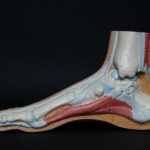If you’re an athlete or someone who loves engaging in physical activities, there’s one thing you can’t afford to overlook: your tendons. These vital connective tissues play a crucial role in keeping our muscles and bones functioning smoothly. However, they are also prone to injuries that can bring your active lifestyle to a screeching halt. But fear not, because in this article, we’ll delve into the world of tendon injuries and explore proven strategies to safeguard your tendons and prevent these setbacks. So, whether you’re a sports enthusiast or simply looking to stay injury-free, read on to discover how you can protect those precious tendons and keep your body performing at its best.

How to Prevent Tendon Injuries
As a seasoned physiotherapist specializing in sports injuries prevention and rehabilitation, I understand the importance of safeguarding tendons to prevent injuries. When it comes to tendon health, taking proactive measures is key. In this article, I will share proven strategies and expert advice on how to prevent tendon injuries and promote a safe and healthy exercise routine.
Warm Up and Stretch: Prepare Your Body
One of the most crucial steps in preventing tendon injuries is to warm up your body before any physical activity. By spending just 10 minutes engaging in light cardiovascular exercises, such as jogging or jumping jacks, you can increase blood flow to the muscles and tendons, preparing them for the upcoming workout. Stretching before and after a sporting event is equally important. Performing gentle stretches can help improve flexibility, reduce muscle tension, and prevent strain on the tendons.
“Remember, a proper warm-up and stretching routine is your first line of defense against tendon injuries.”
Maintain a Balanced Fitness Program
Another essential strategy is to maintain a balanced fitness program that incorporates cardiovascular, strength, and flexibility exercises. Regular cardiovascular exercise, such as running or cycling, improves blood circulation and keeps tendons healthy. Strength exercises, like weightlifting or resistance training, help build strong muscles that support the tendons.
Furthermore, do not ignore the importance of flexibility exercises, such as yoga or Pilates. These activities improve joint mobility and prevent stiffness, which can put strain on the tendons. By combining all three types of exercises, you will create a strong foundation for your tendons, reducing the risk of injury.
“Remember, a balanced fitness program is like a well-oiled machine that supports and protects your tendons.”
Choose Proper Equipment
Don’t underestimate the significance of using proper equipment that fits well and supports your tendons. When it comes to athletic shoes, opt for ones specifically designed for your activity of choice. These shoes provide cushioning, stability, and shock absorption, reducing the impact on your tendons. Additionally, make sure your shoes fit correctly, as ill-fitting footwear can lead to strain on the tendons.
“Remember, the right equipment can make all the difference in preventing tendon injuries.”
Listen to Your Body and Take Breaks
Pushing yourself beyond your limits can be tempting, especially when you’re passionate about your sport or exercise routine. However, it’s vital to listen to your body and recognize the signs of overexertion or tendonitis. If you experience pain, swelling, or discomfort, take a break from strenuous activities. Ignoring these warning signs can lead to more severe injuries and longer recovery times. Instead, choose low-impact alternatives, such as swimming or cycling, to give your tendons the rest they need.
“Remember, your body speaks to you through pain. Listen to it and respect its limitations.”
Utilize RICE Technique: Reduce Pain and Swelling
When an injury does occur, applying the RICE technique can help reduce pain and swelling. RICE stands for Rest, Ice, Compression, and Elevation. Rest the injured area, avoiding further stress on the tendon. Apply ice packs wrapped in a cloth to the affected area for about 15-20 minutes every few hours to reduce inflammation. Compression, through the use of a bandage or brace, can provide support and help control swelling. Finally, elevate the injured limb above the heart level to minimize swelling.
“Remember, the RICE technique is a simple yet effective way to aid in the recovery process.”
Follow Medical Recommendations and Allow Sufficient Rest
If you’re dealing with a tendon injury, it’s important to follow your doctor’s recommendations and give yourself enough rest until the injury heals. Trying to rush the recovery process or returning to physical activity too soon can exacerbate the injury and prolong the healing period. Allow your body the time it needs to repair and rebuild the damaged tendons. Additionally, discuss with your doctor or physiotherapist about a personalized exercise program to gradually strengthen the tendons and prevent future injuries.
“Remember, patience and proper rest are the building blocks for a strong and resilient tendon.”
Seek Information from Trusted Sources
To ensure you are well-informed about tendon injuries and their prevention, seek guidance from trusted sources. Websites like my.clevelandclinic.org, hopkinsmedicine.org, mayoclinic.org, footproadvice.com, and medi-dyne.com provide reliable information from reputable experts in the field. Stay up-to-date with the latest research, tips, and techniques to keep your tendons healthy and prevent injuries.
In conclusion, by following these proven strategies, you can minimize the risk of tendon injuries and safeguard your tendons. Remember to warm up and stretch properly, maintain a balanced fitness program, choose proper equipment, listen to your body, utilize the RICE technique when needed, follow medical recommendations, and seek information from trusted sources. Taking these proactive measures will promote tendon health and allow you to enjoy a safe and fulfilling exercise routine.
“Don’t wait until your condition worsens before taking action. Start implementing these strategies today and protect your tendons for a lifetime.”
Tendons are fascinating structures in our bodies that play a crucial role in movement and stability. Have you ever wondered about the secrets they hold? Well, here are 3 facts about tendons that will leave you amazed.
Did you know that tendons are incredibly strong and tough? They are made up of a dense band of connective tissue that can withstand tremendous amounts of tension. It’s like having super-strong ropes in our bodies that hold everything together!
Another intriguing fact is that tendons have a remarkable ability to adapt and strengthen. When we engage in regular exercise or physical activities, our tendons respond by becoming thicker and stronger. This adaptation process allows us to become more resilient and perform better in various activities.
And here’s a mind-boggling fact: tendons have a limited capacity to heal themselves. When a tendon is injured or damaged, its healing process is often slow and challenging. That’s why it’s crucial to take care of our tendons and avoid overloading them to prevent injuries.
If you’re eager to learn more about tendons and unravel their mysteries, click here to discover 3 fascinating facts about tendons. Get ready to be amazed by the wonders that lie beneath the surface of our bodies!
FAQ
Question: Why is warming up important before exercising?
Answer: Warming up before exercising is important because it helps increase blood flow to the muscles and tendons, making them more flexible and reducing the risk of injury. It also prepares the body for the physical demands of exercise.
Question: How can maintaining a balanced fitness program help prevent tendon injuries?
Answer: Maintaining a balanced fitness program that includes cardiovascular, strength, and flexibility exercises helps to strengthen the muscles and tendons, making them more resistant to injury. It also improves overall fitness and coordination, reducing the risk of tendon injuries.
Question: Why is proper equipment important for safeguarding tendons?
Answer: Using proper equipment, such as athletic shoes that fit well and provide adequate support, is crucial for safeguarding tendons. Proper equipment helps to distribute forces evenly, reducing the strain on tendons during physical activity and decreasing the risk of injury.
Question: Why is rest important in the recovery process of tendon injuries?
Answer: Rest is important in the recovery process of tendon injuries because it allows the injured tendons to heal properly. Taking a break from strenuous activities and giving the tendons enough rest helps to reduce inflammation, pain, and further damage.
Question: How can applying ice, compression, and elevation help in the initial management of tendon injuries?
Answer: Applying ice, compression, and elevation to the injured area can help reduce pain and swelling associated with tendon injuries. Ice helps to reduce inflammation, compression provides support and reduces swelling, while elevation helps to minimize swelling by allowing fluid to drain away from the injured area.
- Senior at What Age: Benefits & Eligibility Guide - March 29, 2025
- Unlocking Senior Benefits: How Old is a Senior? Your Complete Guide - March 29, 2025
- Master Russian Politeness:A Guide to Saying Please - March 29, 2025
















